Out of the 88 officially recognized constellations, there are only a handful that look anything like the object, person, or creature they are supposed to represent. Taurus, the Bull, is one of them. The constellation Taurus is not only one of the most recognizable star patterns in the night sky but also holds significant importance both historically and astronomically.
Covering an area of 797 square degrees, Taurus is impressive in size. Among the 88 official constellations that adorn our night sky, Taurus ranks as the 17th largest, making it a relatively expansive star pattern. One of its most notable features is its position as the radiant point for the annual Taurid meteor shower. This celestial event happens every November and draws stargazers worldwide to witness the meteors that seem to radiate from Taurus.
Taurus is part of the zodiac family of constellations, a group that has particular significance in astrology. These are the constellations that the sun, moon, and planets pass through. This makes Taurus, like its zodiac counterparts, an essential point of reference for astrologers and those who follow their horoscopes.
Look upon any clear autumn or winter night, and you’ll find it stampeding across the sky toward Orion, the Hunter. Orion has his club and shield raised high to defend himself. This is how the ancient Greeks first imagined the constellation, but they weren’t the first to identify its stars.
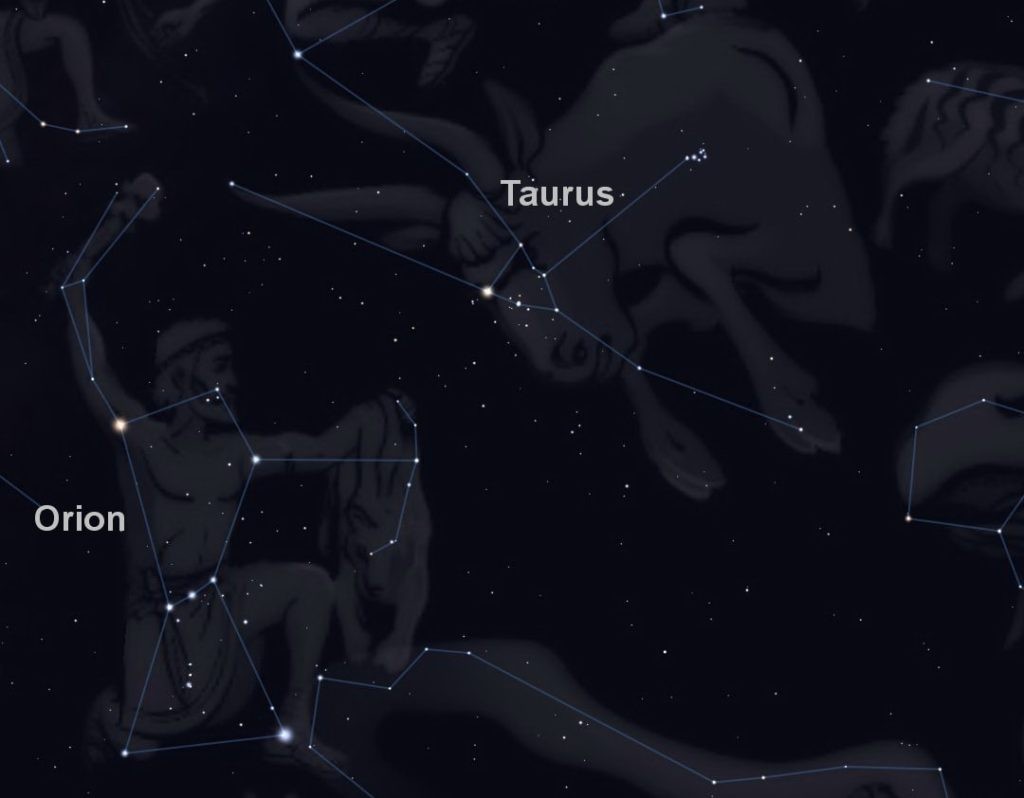
Where is Taurus, The Bull, Constellation in the Sky?
Taurus the Bull is visible across a wide range of latitudes, spanning from +90° to -65°. This makes the constellation accessible to observers in both the Northern and Southern Hemispheres. In terms of celestial coordinates, Taurus boasts an average right ascension of 4.9h, and straddles the celestial equator as well as the ecliptic plane.
How to Locate Taurus
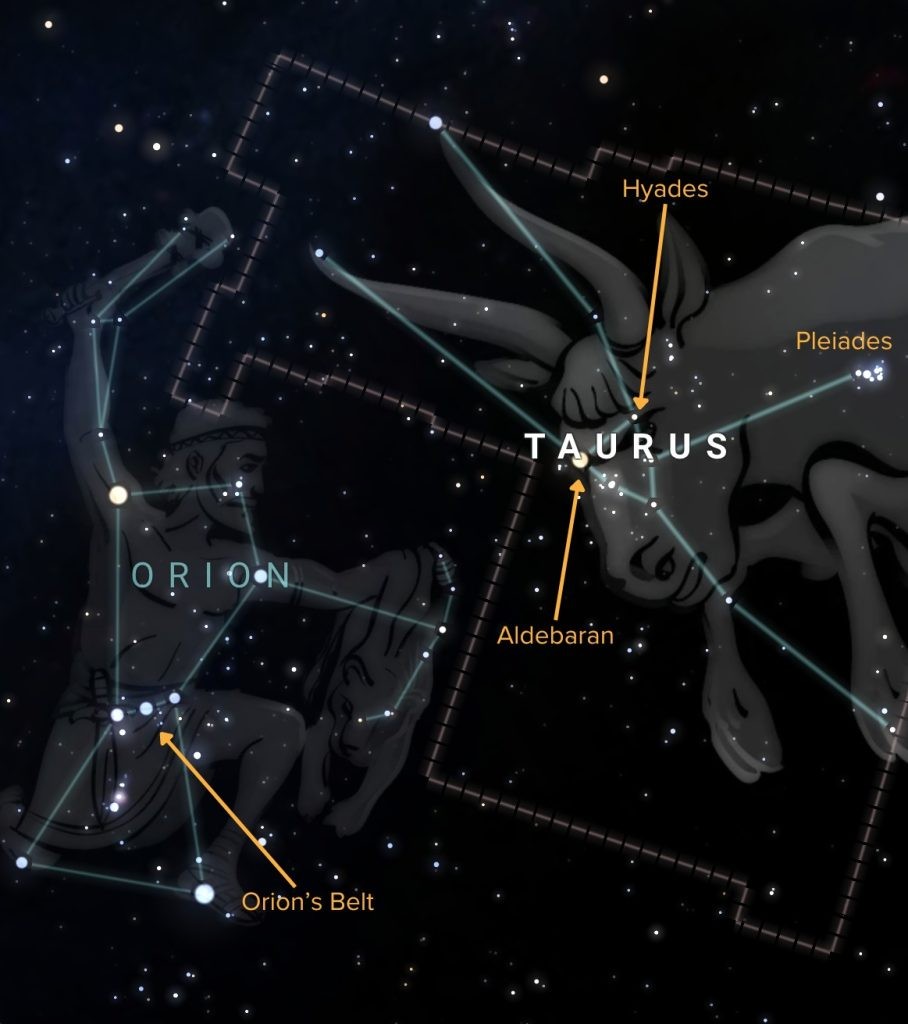
- Using Orion’s Belt: One of the most straightforward methods to locate Taurus is by using the nearby constellation Orion, particularly the three bright stars that form Orion’s belt. Draw an imaginary line through these stars, and it will guide you to the bright, reddish star Aldebaran, Taurus’s brightest star. This is the eye of the Bull and lies at the center of the V-shaped Hyades star cluster, which represents the bull’s head.
- Through the Pleiades Cluster: Another method, if Orion is not visible yet, to spot Taurus is by identifying the famous Pleiades star cluster, sometimes known as the Seven Sisters or Subaru cluster. This small and compact cluster of stars, resembling a tiny dipper, is a part of Taurus and is located to the northwest of Aldebaran and the Hyades. The Pleiades are visible to the naked eye almost anywhere but the most light-polluted city centers.
What to See in the Taurus
Important Stars in Taurus Constellation
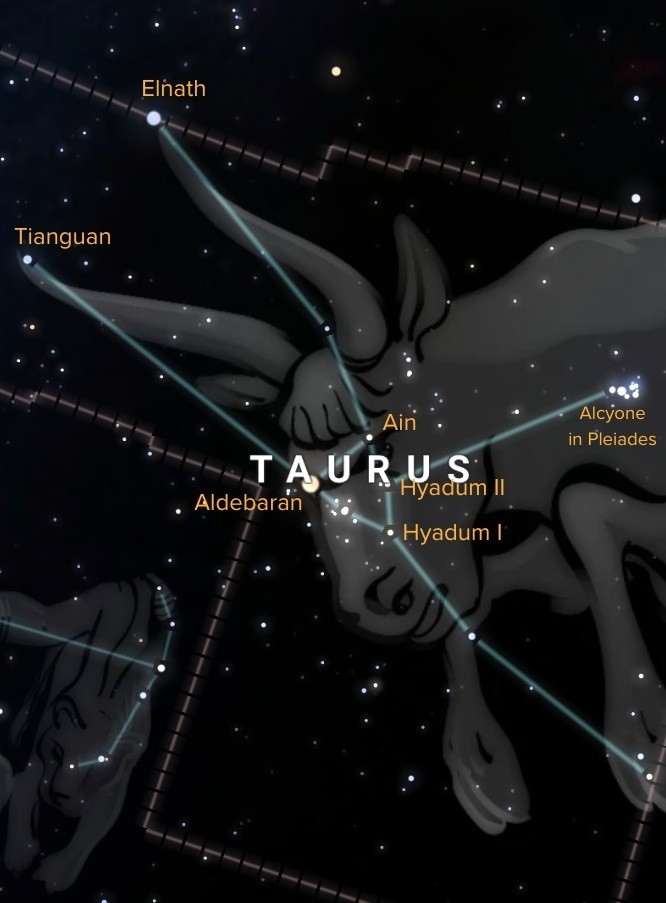
Aldebaran, ranking as the 14th brightest star in our night sky, holds an illustrious history. It’s been revered by diverse civilizations for millennia and is deeply rooted in legend.
Aldebaran emanates a vibrant orange hue when observed with the unaided eye. This vividness inspired the Greeks to perceive it as the Bull’s fiery eye. Scientifically, Aldebaran is a colossal K-type red giant star, dwarfing our Sun at approximately 45 times its size and shining 500 times brighter, but in fact, it is a preview of our Sun’s future. Aldebaran is just 16% more massive than the Sun and is going through the same red giant stage our star will start in about a billion years from now. Aldebaran is about 1.5 billion years older than our Sun, and thus it became a proper red giant fairly recently. Its diameter currently stretches as far as the orbit of Mercury, and it will one day grow to as far out as Mars orbits the Sun shortly before it puffs away into a planetary nebula.
Aldebaran is relatively nearby, only 65 light years away from us. Aldebaran’s position near the ecliptic plane means it frequently makes conjunctions or occultations with the Moon or the planets, and it’s a spectacular sight to see the Bull briefly sport a pair of eyes or to watch the star disappear and reappear behind the Moon.
Notably, besides Aldebaran, the Taurus constellation boasts other standout stars like Elnath and Alcyone. Elnath, marking the Bull’s horn tip, is the constellation’s second-brightest star. Meanwhile, Alcyone, as the brightest star within the Pleiades cluster, exudes a blue-white brilliance, holding its own tales in the vast lore of Taurus.
Star Clusters in Taurus Constellation
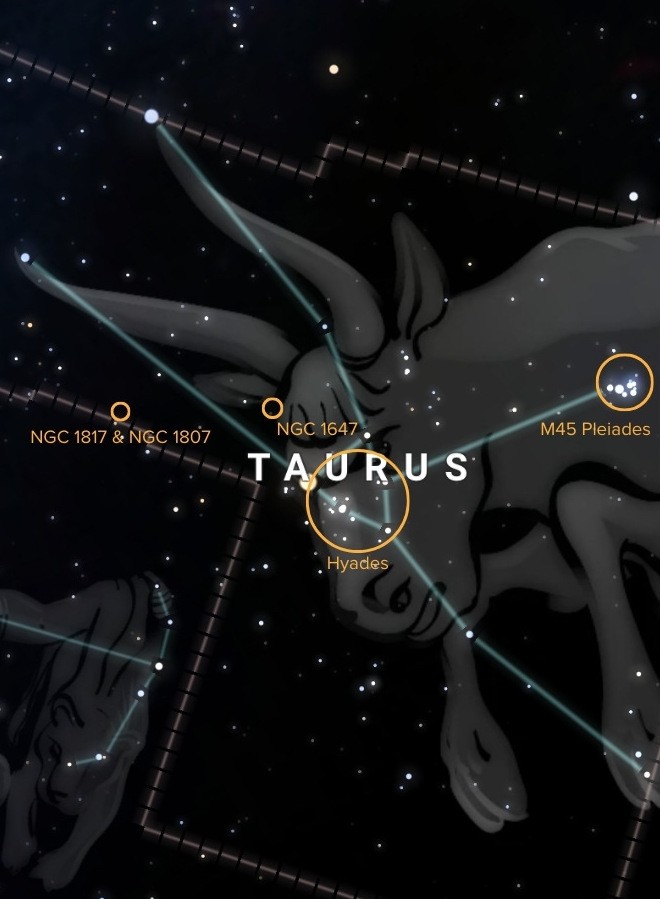
Upon closer examination, Aldebaran seems to nestle within a V-shaped constellation of dimmer stars, recognized as the Hyades, embodying the Bull’s face. However, Aldebaran, at a mere 65 light-years away, is not a Hyades member; it’s an optical illusion caused by our line of sight.
The vastness of the Hyades, nearly tenfold the area of a full moon, is paradoxically deceptive to the naked eye. A telescope might not do justice to its grandeur; instead, binoculars, particularly 10×50 variants, offer a supreme view, capturing the entire cluster seamlessly. Within the Hyades, astute observers might spot binocular double stars. If you align your gaze from Orion’s belt through Aldebaran, the captivating cluster of the Pleiades unveils itself, easily discernible even against light-polluted skies.
Often referred to as the “Seven Sisters” both in mythology and by stargazers, the Pleiades paradoxically appear as a prominent six to the unaided eye, though you can see a dozen or so stars in all with especially sharp eyesight; a telescope or binoculars will reveal hundreds of stars.
The Pleiades (M45) offer a celestial spectacle unmatched in the night sky. Best appreciated through binoculars or telescopes with minimal magnification (ideally 35x or less), the cluster boasts over a thousand stars, residing roughly 450 light-years away from Earth. These nascent stars, aged at an approximate 100 million years, remain in close proximity.
Photographs of the Pleiades depict the stars enshrouded in a stunning blue reflection nebula. Contrary to earlier beliefs that considered this nebula the birthplace of these stars, contemporary studies suggest this nebulous encounter is coincidental as the stars journey through space. This reflection nebula is visible in telescopes as small as 6” in aperture under a dark sky, but you have to be careful not to confuse it with glare or smudges on your optics. Low power is ideal. Look for a comma-shaped cloud coming off of Merope; if you can see that easily enough, you should be able to trace a large bubble of faint, wispy nebula for several degrees around the cluster with a suitably good telescope.
NGC 1647, near the border Taurus shares with the constellation Aries, is a relatively overlooked gem. This open star cluster contains over 150 stars and spans around 45 light years in diameter. At an approximate age of 150 million years, it’s considered to be relatively young. When observed with a small telescope or binoculars, NGC 1647 offers a beautiful scattering of stars that seem to be loosely bound by gravity.
NGC 1817 and NGC 1807 are a pair of close-together open star clusters, often referred to as the “other” Double Cluster like the one in Cassiopeia. The pair contains around a thousand stars and may actually be a single extended cluster.
Other Taurus Deep-Sky Objects
Taurus is not just a hub for star clusters. It’s also home to a few unique nebulae, though galaxy observers are likely to be disappointed in the sparseness of this constellation.
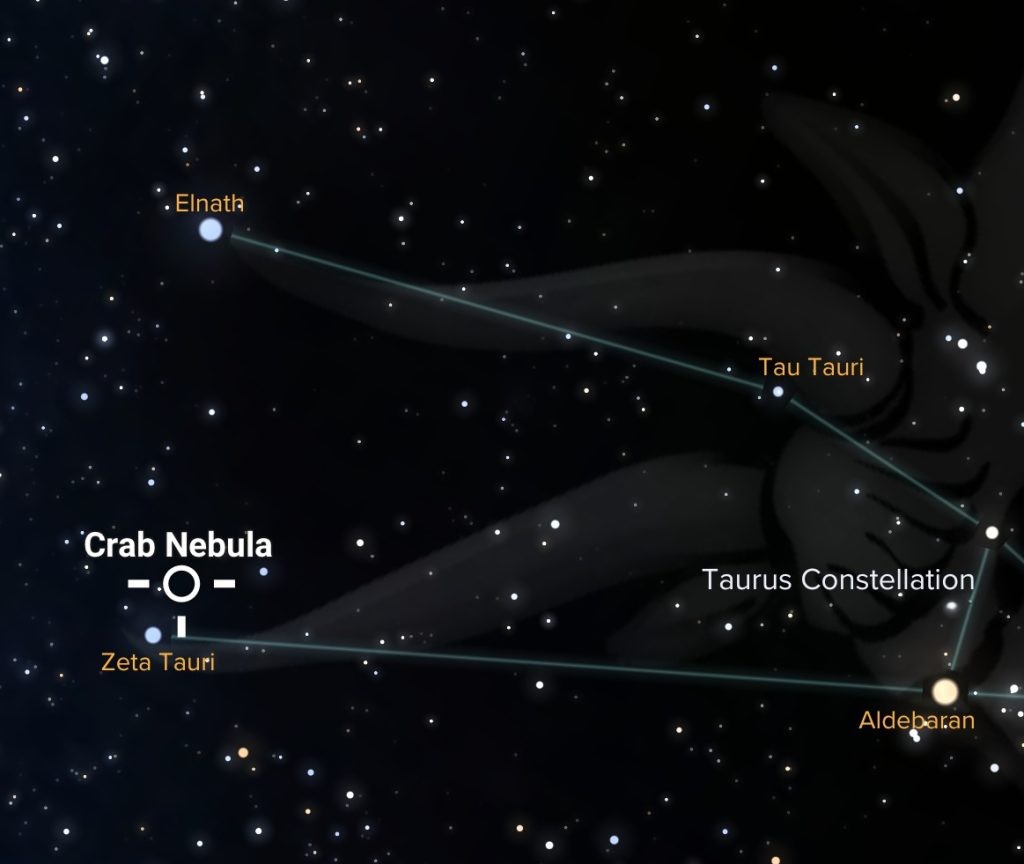
Arguably one of the most famous supernova remnants, M1, also known as the Crab Nebula, is the aftermath of a supernova explosion observed by Chinese astronomers in 1054 AD. This nebulous cloud stands as a testament to the violent death of a star. With its intricate structures and tendrils of gas and dust, it’s a favorite target for both amateur and professional astronomers. At its core lies a pulsar—a rapidly spinning neutron star emitting intense radiation. The pulsar and its flicker are visible in 20” and larger telescopes; the nebula itself is visible in instruments as small as 4” even under fairly light-polluted skies but often disappoints even with dark skies and a nebula filter. The Crab is slowly expanding and dimming every year, and it is significantly dimmer and lower in contrast against the background sky today than when it was discovered in the 1700s.
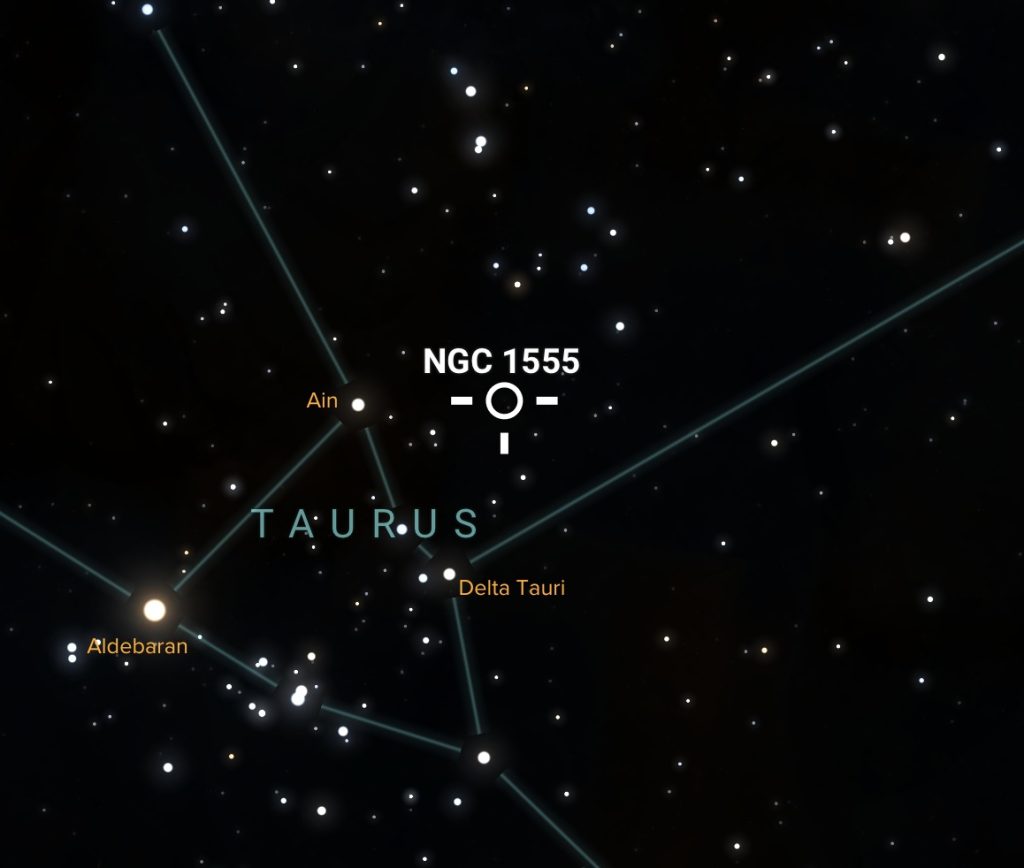
Named after the British astronomer John Russell Hind, who discovered it in 1852, Hind’s Variable Nebula (NGC 1555) is a reflection nebula surrounding the star T Tauri. Its brightness varies, which is quite uncommon for nebulae, leading to its distinctive name. The variations in brightness are believed to be caused by changes in the output of T Tauri, the young star at its center, and by changes in how the star illuminates the surrounding nebula. The nebula appears as a small cone-shaped wisp in telescopes, visible even under fairly light-polluted skies with an aperture of 6” or greater.
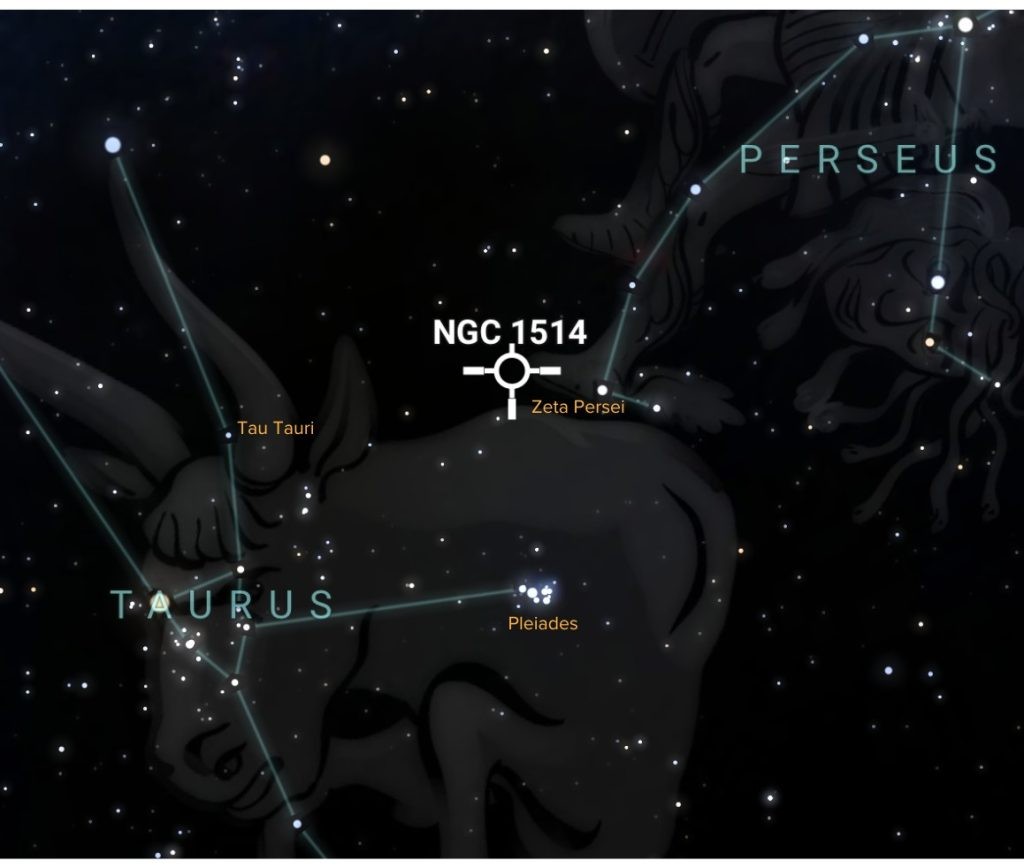
Another enchanting deep-sky object located in Taurus is the Crystal Ball Nebula, also known as NGC 1514. This planetary nebula was discovered by William Herschel in 1790, and it left a profound impact on his understanding of nebulae. Before the discovery of NGC 1514, it was widely believed that nebulae were simply unresolved clusters of stars. However, the Crystal Ball Nebula’s structure challenged this belief. At its core lies a bright central star enveloped by a relatively faint, circular cloud of illuminated gas, resembling a shimmering crystal ball.
The central star of NGC 1514 is in fact a binary system, and one star is a Wolf-Rayet star, ejecting its outer layers as it dies, producing the nebula. This makes NGC 1514 one of the few planetary nebulae in the sky that is actually still in the process of forming. It glows blue from ionized oxygen atoms and other gases that are extremely hot, having just been ejected from the star. NGC 1514 spans about 2 arcminutes in diameter, making it a reasonably large target, and it is fairly easy to see with a 6” or larger telescope; a UHC or OIII filter helps if you’ve got light pollution to contend with. Larger telescopes, 12-16” or greater, will bring out the bluish color of the nebula.
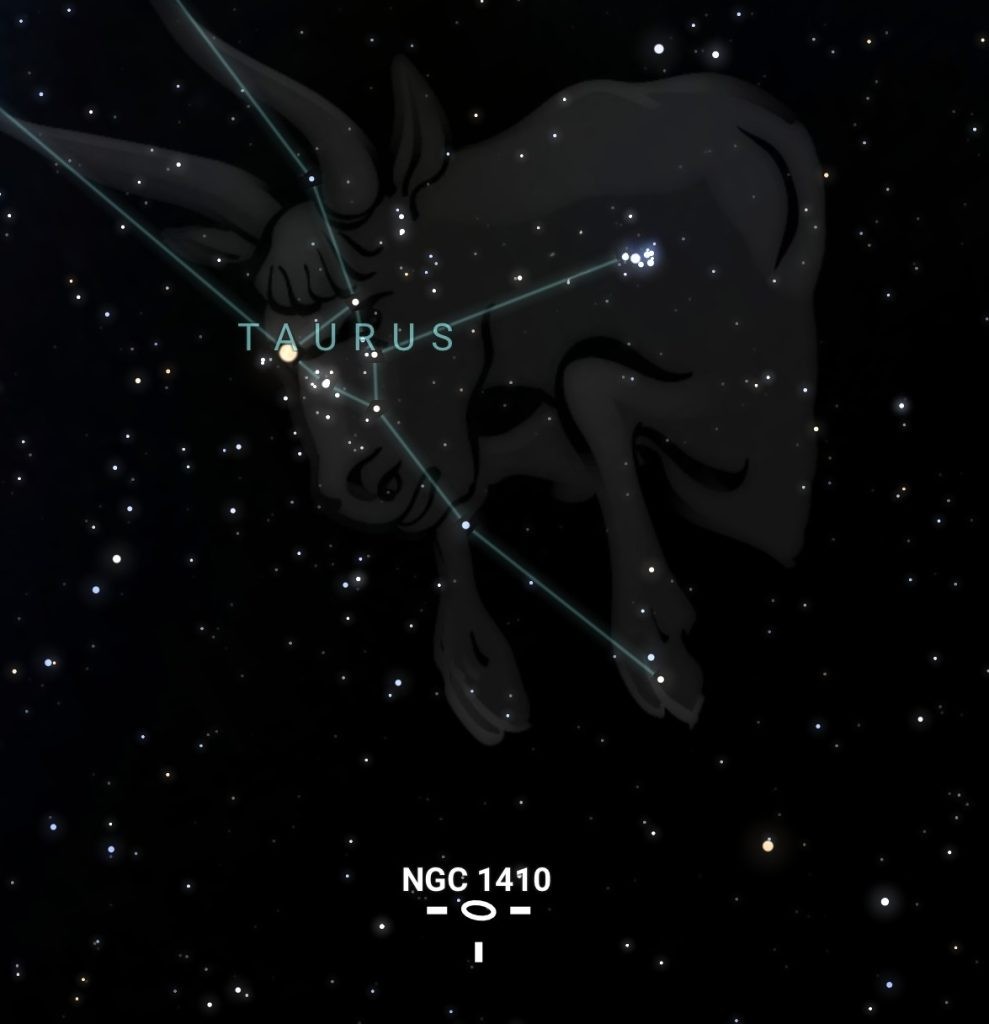
Finally, the captivating duo of NGC 1410 and 1409 is an interacting galaxy pair located in Taurus. Their gravitational dance has led to fascinating tidal interactions, creating an exquisite celestial scene. NGC 1410, a luminous blue galaxy, appears to be drawing material from its partner, NGC 1409. The intense activity in these galaxies, especially in NGC 1410, triggers new star formation, making it a hotbed of stellar birth. However, at around magnitude 15, both of these galaxies are really only able to be observed with a 16” or bigger telescope.
Meteor Showers in Taurus
The most notable meteor shower associated with Taurus is the aptly-named Taurids. These meteors originate from the constellation, with the radiant point nestled within Taurus. The Taurids actually consist of two separate showers: the Northern Taurids and the Southern Taurids. Both showers peak annually in late October and early November. Known for their prolonged activity (lasting from September to December) and relatively slow-moving meteors, Taurids are not particularly dense but can produce bright fireballs, making them an exciting spectacle for stargazers.
The Taurids are believed to be remnants of the tail of Comet Encke, a well-known comet that orbits the Sun approximately every 3.3 years. As Earth moves through this trail of debris, particles burn up in our atmosphere, resulting in the meteor shower. Observers can expect to see around 5-10 meteors per hour during the Taurids’ peak.
The daytime Beta Taurid meteor shower is the counterpart to the Taurid meteor shower and is also produced by Comet Encke, but it occurs during the day, making it largely unobservable. The Beta Taurids are active from June to July, with the peak typically around late June. Though this shower has a relatively low rate of meteors, it is notable because of its association with the Tunguska event of 1908, a massive explosion in Siberia believed to have been caused by an asteroid or comet fragment. Some astronomers speculate that the Tunguska object might have been a large Beta Taurid. Another daytime meteor shower, the Zeta Taurids, peaks around May 31st.
While the radiant of the Geminid meteor shower lies in the constellation Gemini, it’s worth noting here due to the proximity of the two constellations in the sky. The Geminids are one of the most prolific meteor showers of the year, occurring in mid-December. Observers can see up to 120 meteors per hour during the peak. Though its radiant is in Gemini, meteors can appear across the night sky, including within the boundaries of Taurus.
For observing meteor showers, especially the relatively faint Taurids, you should always try to get under as dark a sky as possible. Light-polluted locales may have little chance of seeing any meteors at all. To improve your odds, lie flat on your back with your feet facing the sky and look up, taking in as much of the sky as possible.
